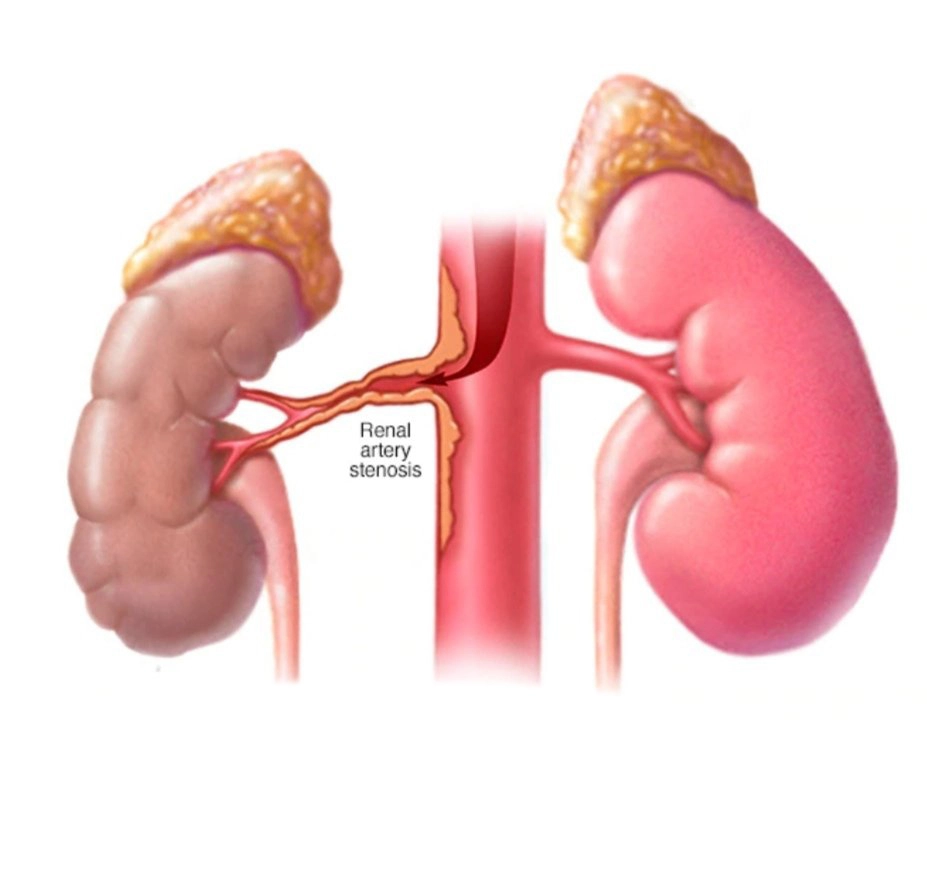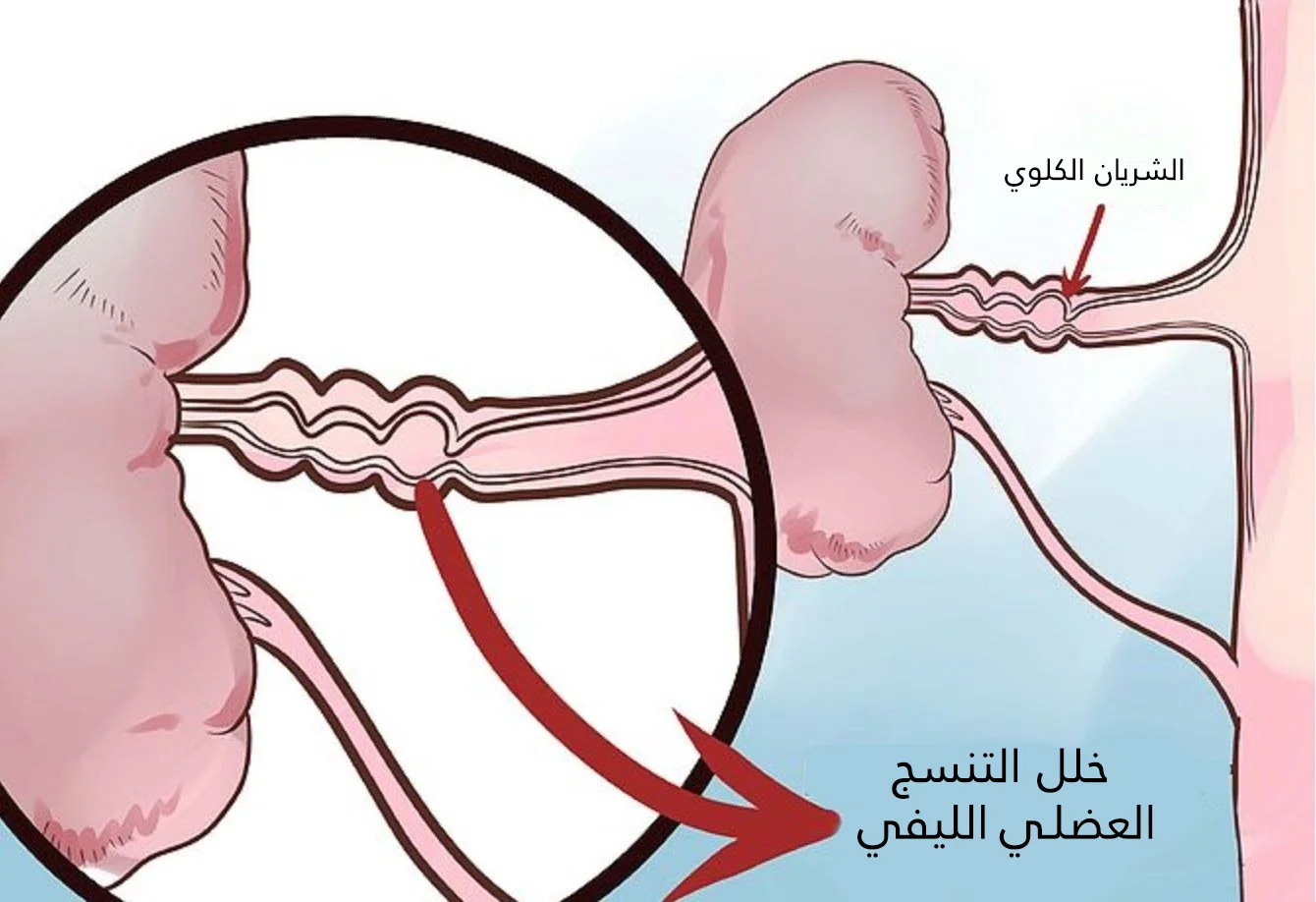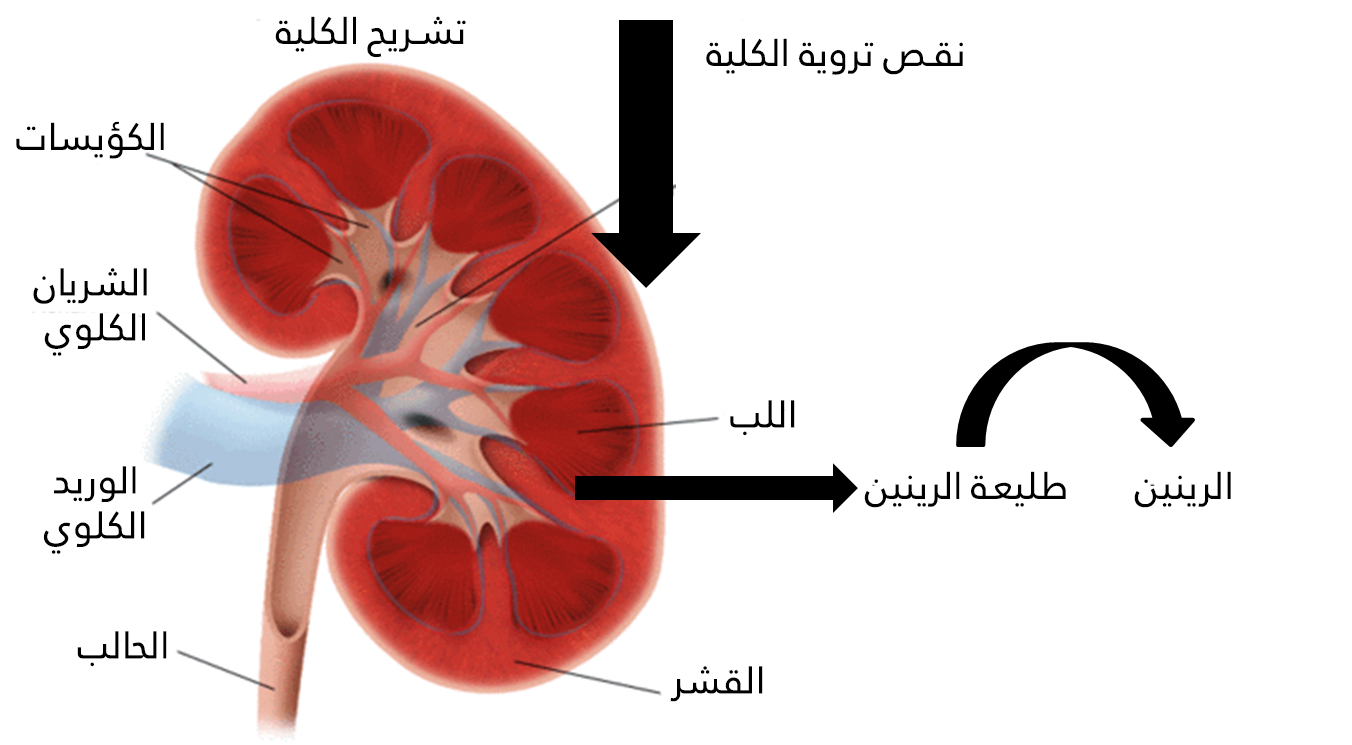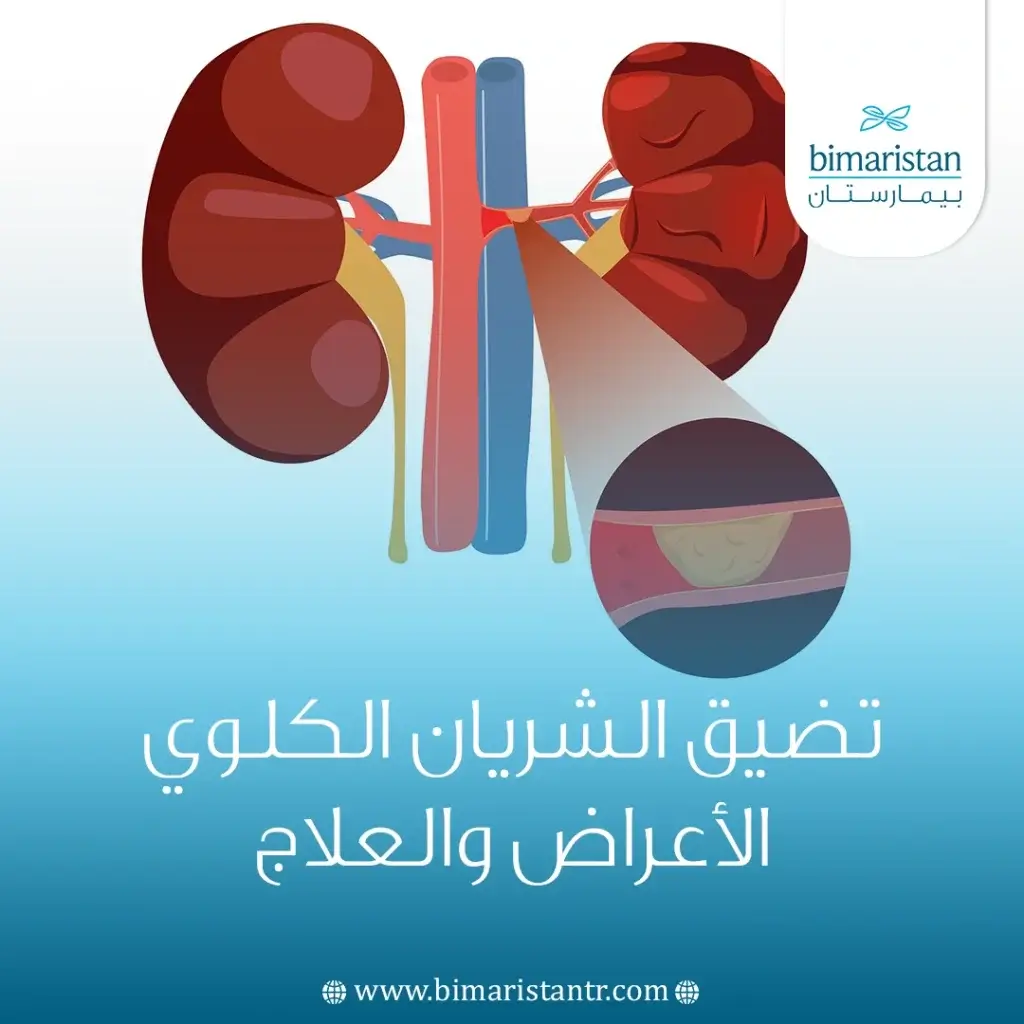تضيق الشريان الكلوي هو تضيق الشريان المُغذي للكلى، والذي يؤدي إلى ارتفاع الضغط الثانوي والتي من الممكن علاجها في تركيا قبل فوات الأوان إما بالقسطرة أو الجراحة.
ماهو تضيق الشريان الكلوي؟
تضيق الشريان الكلوي renal artery stenosis هو تضيق الشريان المُغذي للكلى سواءً من جانب واحد أو من الجانبين (أي في شريان كلية واحدة أو كليهما).
يحدث التضيّق في 80 % من الحالات بسبب حدوث تصلب في الشرايين، الشريان الرئيسي (الأبهر) والشريان المتفرع منه (الكلوي).
نتيجة لذلك، يمكن أن يتطور ارتفاع الضغط الشرياني الناجم عن تنشّط نظام الرينين أنجيوتنسين ألدوستيرون.
لذلك، غالباً ما يكون تضيّق الشريان الكلوي مصحوباً بارتفاع ضغط الدم.
يؤثر ذلك في معظم كبار السن المدخنين أيضاً. كما أن 20 % من المرضى يعانون من تضيّق الشريان الكلوي الخلقي (خاصة النساء).
في هذه الحالة، يحدث تضيّق الشرايين الكلوية بسبب عضلات جدار الوعاء الدموي وهيكل النسيج الضام في الوعاء الدموي.
أنواع تضيق الشريان الكلوي
تضيق الشرايين الكلوي التصلبي
يحدث مرض تضيق الشريان الكُلَوي بسبب تصلب الشرايين. عادةً ما يُصاب كبار السن على وجه الخصوص بهذا النوع من تضيّق الشريان الكلوي.

تضيق الشريان الكلوي الليفي العضلي
في هذا الشكل من المرض، يزداد سمك جدار الأوعية الدموية للشريان الكلوي، وبالتالي تضيق في فتحة الأوعية الدموية. هذا الشكل يؤثر بشكل رئيسي على الشباب.
في 1% إلى 5% من جميع الحالات، يكون ضيق الشريان الكلوي هو سبب ارتفاع ضغط الدم.

أسباب تضيق شرايين الكلى
تصلب الشرايين atherosclerosis
يعد السبب الأكثر شيوعًا لتضيق الشريان الكلوي، ويكون وراء 60% إلى 90% من الحالات.
يحدث بشكل رئيسي عند التقاطع بين الشريان الأورطي والشرايين الكلوية.
خلل التنسج العضلي الليفي fibromuscular dysplasia
وهو عبارة عن تغيرات في النسيج الضام الوعائي .
وتكثر الإصابة بهذه الحالة من تضيق الشريان الكلوي عند المرضى الصغار ويحدث على الأرجح في الثلث الأوسط من الشريان الكلوي.
التهابات الشرايين
مثل التهاب الشرايين تاكاياسو (التهاب الأورطي غير المحدد).
أسباب أخرى نادرة
مثل الإصابات أو تمدد الأوعية الدموية في الشريان الكلوي أو التخثر.
يمكن تفسير الفيزيولوجيا المرضية لتضيق الشريان الكلوي من خلال تأثير جولدبلات. إذا تم تقليل قطر الشريان الكلوي إلى أقل من 40 بالمائة، فإن تدفق الدم في الكلى ينخفض.
تتفاعل الكلى مع انخفاض تدفق الدم ممايؤدي إلى زيادة إطلاق الرينين، والذي يؤدي عن طريق نظام الرينين – أنجيوتنسين – ألدوستيرون إلى انقباض الأوعية (تضيق الأوعية) وزيادة امتصاص الصوديوم والماء.
ينتج عن ذلك زيادة في ضغط الدم الجهازي.
بهذه الطريقة، تحاول الكلى المريضة تحسين تدفق الدم المقيّد ، ولكنها أيضًا تزيد الضغط في الدورة الدموية بالجسم ليصل إلى قيم تعتبر مرضية.
أعراض تضيق الشريان الكلوي
ليس من الضروري دوماً أن تظهر أعراض للمرض، بل من الممكن أيضاً أن يستمر دون أعراض.
ومع ذلك ، يحدث ارتفاع ضغط الدم في الأوعية الدموية في كثير من الحالات. و
هو ارتفاع ضغط الدم الناتج عن أمراض الكلى. بالإضافة إلى ذلك، ينخفض تدفق الدم إلى الكلى، مما قد يؤدي إلى ضعف الكلى.

بشكل عام، تشمل الأعراض الممكن حدوثها ما يلي:
- ارتفاع ضغط الدم (خاصة ضغط الدم الانبساطي)
- نقص تأثير الساعة البيولوجية على العمليات الحيوية (أي أنها لا تتفق مع دورة الليل والنهار)
- صوت تضيق في منطقة السرة (في حوالي 40 بالمائة من المرضى)
- في المراحب المتقدمة من المرض، غالبًا ما تتطور قيم ارتفاع ضغط الدم بسرعة
تشخيص تضيق الشريان الكلوي
عند الأشخاص النحيلين، يمكن ملاحظة تضيق الشريان الكلوي باستخدام سماعة الطبيب.
أثناء الفحص البدني، تُسمع ضوضاء تدفق في منطقة البطن والخصرين، مما يشير إلى حدوث تغييرات في الأوعية الدموية للكلى.
يتم تشخيص تغير الأوعية الدموية بشكل أساسي من خلال فحص الموجات فوق الصوتية للكلى والأوعية الدموية.
أثناء الفحص، يمكن قياس معدل تدفق الدم عبر الأوعية وعرض الوعاء الدموي.
إذا كان من الممكن اكتشاف انقباض كبير مع سرعة تدفق منخفضة، فإن العلاج ضروري.
لا يتم استخدام الأشعة السينية في الفحص بالموجات فوق الصوتية، وهذا هو السبب في أنها مريحة بشكل خاص للمريض.
خيار آخر هو ما يُعرف باسم تصوير الأوعية الدموية بالرنين المغناطيسي ، حيث تظهر الأوعية الكلوية بدقة شديدة.
هنا يحقن المريض بوسيط تباين عبر الوريد ، يمكن من خلاله جعل الأوعية الكلوية مرئية بوضوح.
علاج تضيق الشريان الكلوي
تتوفر خيارات العلاج التالية:
العلاج الدوائي
تستخدم مثبطات الإنزيم المحول للأنجيوتنسين مع حاصرات بيتا كدواء. لكن عندما يفشل العلاج الدوائي، وعند عدم وجود تحسن في قيم ضغط الدم، تصبح الإجراءات الجراحية خياراً مطروحاً.
ملحوظة: في حالة تضيق الشريان الكلوي في الكليتين معاً أو بحالة وجود كلية واحدة، يمكن أن يؤدي العلاج بمثبطات الإنزيم المحول للأنجيوتنسين إلى فشل كلوي حاد ولا ينصح به في هذه الحالة.
العلاج التداخلي – رأب الأوعية الدموية عن طريق الجلد PTA
يؤدي رأب الأوعية الدموية عن طريق الجلد (PTA) إلى النجاح في 80% من حالات تضيق الشريان الكلوي، وغالبًا مع زرع أنبوب مؤقت لاحقاً. كما هو الحال مع قسطرة القلب، يتم دفع بالون إلى الشريان الكلوي عن طريق قسطرة. ثم يتم توسيع هذا البالون في موقع الخلل لتوسيع الوعاء.
إذا لزم الأمر، يمكن استخدام أنبوب مؤقت داخل الأوعية الدموية. يهدف الأنبوب المؤقت إلى ضمان بقاء الوعاء الدموي مفتوحاً
يتم تنفيذ (PTA) فقط إذا كان العلاج الدوائي لارتفاع ضغط الدم لا يؤدي إلى انخفاض كافٍ في الضغط أو إذا كان الشريان مسدودًا بنسبة تزيد عن 70٪ وبالتالي لا يُتوقع حدوث تحسن في ارتفاع ضغط الدم.
العلاج الجراحي – جراحة الشريان الأورطي أو جراحة المجازة التشريحية
في حالات نادرة ، قد تكون العملية الجراحية ضرورية، على سبيل المثال، إذا لم ينجح علاج القسطرة.
أثناء إجراء الجراحة، تتم إزالة الجزء الضيق من الوعاء الدموي، وإذا لزم الأمر، يتم ربطه بطرف وعائي اصطناعي.
إنذار تضيق الشريان الكلوي
يمكن عادةً تصحيح سبب تضيق الشريان الكلوي.
في معظم الحالات ،يمكن الوصول إلى مستوى ضغط دم طبيعي
. ولكن كلما طالت مدة عدم علاج التضيق وكلما كان ضغط الدم مرتفعاً ، قلت فرصة خفض ضغط الدم مرة أخرى، حيث يتكيف الجسم مع ارتفاع ضغط الدم بمرور الوقت.
إذا استمر ارتفاع ضغط الدم، يحدث ما يسمى بضغط الدم المرتفع الثابت.
بالإضافة إلى ذلك ، إذا لم يتم علاج تضيق الشريان الكلوي، فهناك خطر حدوث تقلص في الكلية وفقدان تدريجي في وظيفتها.
يمكن أن تتضخم الكلية غير المصابة بعد ذلك.
بإمكانكم التواصل معنا للتعرف على أحدث طرق العلاج في تركيا.

